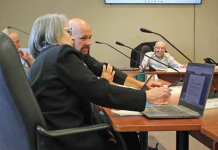By Lisa Gervais
County councillors have an all-day meeting scheduled for Jan. 17 to go over the draft shoreline preservation bylaw.
Nothing has been publicly done since consultants J.L Richards (JLR) and Hutchinson Environmental Services Ltd. (HESL) presented the draft during an Oct. 27, 2021 council meeting.
County Warden Liz Danielsen said it will be council’s first chance to review the final report and recommendations in detail.
“There are a number of options being presented so I anticipate a very fulsome discussion, and no doubt there will be some different opinions about some of the details,” she said.
The new draft bylaw came after nearly five months of community consultation, stakeholder interviews and two sets of surveys and virtual town hall meetings.
Danielsen said, “While I’m sure that all of County Council are committed to the protection of our lakes and shorelines, making decisions to ensure the process has as little impact on residents and businesses is key to the success of the bylaw.”
She added there will not be community input to the meeting as there have been numerous opportunities for public consultation into the process, including a questionnaire, individual interviews, surveys and open houses. However, members of the public are invited to watch the meeting online.
“The County has received hundreds of e-mails and individual councillors have personally heard from interested parties, many in support of the proposed bylaw without reservation, but also others who have concerns about specific aspects of what is proposed,” Danielsen said. “However, there are still folks who are adamantly opposed. Throughout the process we have tried to respond to their concerns and will continue to do so, but given human nature, very few decisions made by councils are unanimously supported.”
She said should the bylaw be adopted, it will be reviewed carefully over the next year to determine its level of success and whether changes need to be made.
“We still have some details to iron out so it may take a bit more time to get the bylaw in place.”
By Sam Gillett
What’s on the table now
• JLR and HESL are recommending keeping the shoreline buffer at 30 metres in any future bylaw. HESL’s scientific review suggests that will remove up to 85 per cent of pollutants, 85 per cent of sediment and 75 per cent of nitrogen from entering lakes. The draft bylaw allows “minor landscaping” which includes the creation of gardens, maintenance and replacement of pathways and driveways up to fivemetres wide, and beaches, as well as the removal of topsoil and up to 25 per cent of trees distributed throughout the shoreline.
• It would also strengthen the existing tree preservation bylaw by requiring permit approval “to any future tree removal or site alteration in the shoreline buffer zone selected by county council.” It prohibits removing native vegetation including trees larger than five-centimetres in width, tree trimming and non-emergency removal of trees and stumps, and the placing of fill or altering the steepness of a shoreline more than a certain amount.
• Also added is the protection of ponds and wetlands, which would be classified as bodies of water. The draft includes allowances for a “lesser shoreline” when a property’s lot depth or site characteristics make it impossible to stick to the 30-metre rule. Applications would include a legal description of a site, a project schedule, and a shoreline plan drawn to scale that includes estimated body of water locations and high watermarks, as well as approximate topography and natural and developed feature locations.
• JLR planner Jason Ferrigan told council the application process was “regarded as a way for the community to grow into the bylaw over time” as well as expanding the matters that can be referred to council, such as when a permit is denied or delayed. The consultants suggest a transition period, where applicants would be free to submit for a year, with a simplified permit system, before moving to the full application system.
• The recommended fines are $925 for first-time offenders and second offence fines maxing out at $100,000.




